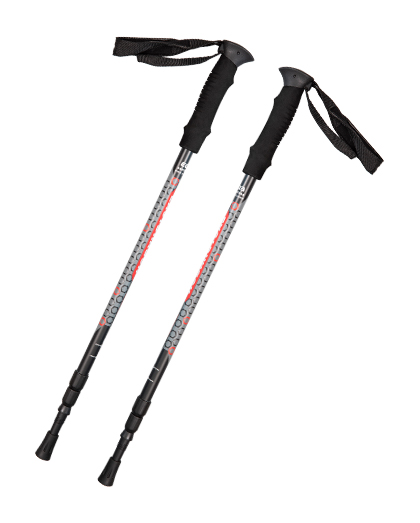

About the adjustment of trekking pole length
The most common outdoor trekking poles on the market are three-section telescopic trekking poles. We will use this kind of trekking pole to explain.

The length of the two sections starting from the point of the battle can be adjusted.
How to adjust the length of the trekking pole? This needs to be adjusted according to the specific terrain.
1. Flat
First, let’s take a look at the length adjustment of walking on a flat ground. We stand on a flat ground, holding a trekking pole, the arm sags naturally, using the elbow as a fulcrum, and lifting the forearm so that the forearm is parallel to the ground and at a right angle to the upper arm. This When holding the trekking pole in your hand, the length of the tip of the pole that touches the ground vertically is the correct length of the trekking pole on the flat ground. You can lock the sections of the trekking pole, and then lock the other unadjusted trekking pole. The length of the trekking pole can be adjusted to the same length.
When walking on a flat ground, a person's arm will naturally swing back and forth. Similarly, when using a trekking pole on a flat ground, the arm swing can be the same as when walking with an empty hand. When the arm swings, the wrist strap will bring the trekking pole forward slightly. When the tip is against the ground, it will push you forward through the role of the wrist strap, just like a rowing boat, but remember that the tip of the stick should not exceed the front of the body.
2. Uphill slope with large slope
Relative to hiking on flat ground, the uphill road with a larger slope needs to shorten the length of the trekking pole, depending on the slope. Place the trekking pole with your arm and place it in front of or above the body, and then use the wrist strap to support the body to walk up. This can effectively reduce the weight of the leg. If necessary, you can use two trekking poles at the same time to do the climbing action. At this time, the palm can be Hold the handle firmly to increase the force.
3. Downhill
Adjust the length of the trekking pole to be slightly longer than the normal length of walking on a flat road, depending on the actual situation. Due to the strong impact on the knee joint when going downhill, you must use a trekking pole to reduce the load. When stepping down, insert the trekking pole into the front of the body, and it must reach the ground before the forefoot to achieve the effect of sharing the power. Special attention is needed, because when walking downhill, the cane bears more weight than usual, so the sections of the cane must be fully fixed firmly to avoid the risk of sudden retraction when the body is replayed, resulting in the risk of body imbalance. . In addition, based on the same reason, you must pay attention to the place where the cane falls. The arm exerts a little pressure on the cane to see if the place is reliable. Don’t encounter places that are prone to collapse, such as mud, empty floating grass below, easy Collapsed cliff edge sandstone, etc.; When adjusting the trekking pole, it should not exceed the maximum adjustment length shown on the trekking pole. Adjust the trekking pole to the longest, you will see a "STOP" or "MAX" mark near the top of the first two sections of the trekking pole, which requires that the trekking pole should not exceed this length when adjusting the length Mark, otherwise it is likely to break when encountering external force. There is a length and size within the "STOP" mark of the trekking pole that can be used as an adjustment reference. When buying trekking poles, you can determine how long the trekking pole you need according to your height.